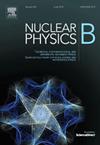大型强子对撞机已经排除了超对称——真的吗?
IF 2.8
3区 物理与天体物理
Q2 PHYSICS, PARTICLES & FIELDS
引用次数: 0
摘要
尽管早期人们希望大型强子对撞机(LHC)能很快发现超对称粒子,但迄今为止还没有发现任何超对称粒子。本文考察了大型强子对撞机的结果对弱尺度超对称的可行性的影响,并讨论了发现超对称粒子的可能性是否仍然可以实现。本文章由计算机程序翻译,如有差异,请以英文原文为准。
The LHC has ruled out supersymmetry – really?
Despite early hopes that the Large Hadron Collider (LHC) would quickly unveil supersymmetric particles, none have been detected to date. This review examines the impact of the LHC results on the viability of weak-scale supersymmetry, and discusses whether the possibility of discovering supersymmetric particles remains within reach.
求助全文
通过发布文献求助,成功后即可免费获取论文全文。
去求助
来源期刊

Nuclear Physics B
物理-物理:粒子与场物理
CiteScore
5.50
自引率
7.10%
发文量
302
审稿时长
1 months
期刊介绍:
Nuclear Physics B focuses on the domain of high energy physics, quantum field theory, statistical systems, and mathematical physics, and includes four main sections: high energy physics - phenomenology, high energy physics - theory, high energy physics - experiment, and quantum field theory, statistical systems, and mathematical physics. The emphasis is on original research papers (Frontiers Articles or Full Length Articles), but Review Articles are also welcome.
 求助内容:
求助内容: 应助结果提醒方式:
应助结果提醒方式:


